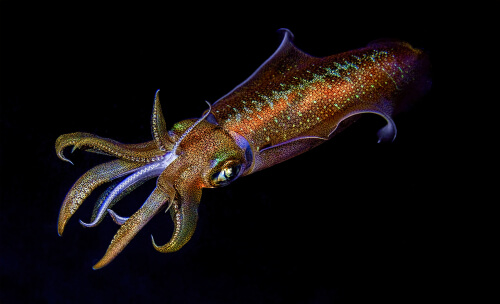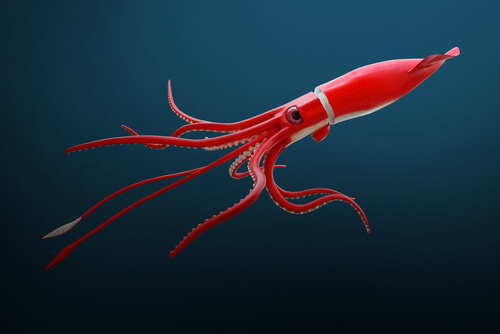
| Kingdom | Animalia |
| Phylum | Mollusca |
| Class | Cephalopoda |
| Order | Oegopsida |
| Family | Architeuthidae |
| Genus | Architeuthis |
| Species | A. dux |
| Niche | Deep-sea cephalopod |
| Length | Up to 43 ft (13 m) |
| Weight | 606 lb (275 kg) |
| Lifespan | 5 years |
| Social Structure | Solitary |
| Conservation Status | Least concern |
| Preferred Habitat | Deep ocean |
| Average Number of Eggs | 50-300 |
| Main Prey Species | Fish, squid, crustaceans |
| Predators | Sperm whales |
The Basics
The giant squid is a cephalopod species native to the deep sea. They are elusive and rarely observed alive, but are famous for their immense size, growing up to 43 ft (13 m) in length and weighing up to 606 lb (275 kg). Indeed, the giant squid is one of the largest known invertebrate species living today, second only to the colossal squid. There is some debate about the number of different species of giant squid. However, the most recent genetic evidence suggests that there is only one known species, Architeuthis dux.
Description
The Giant squid appears similar to many other more commonly observed squid species. They have eight arms and two longer tentacles surrounding their hard beaks and radula, a unique structure used for breaking food into pieces small enough to ingest. At the base of their tentacles the mantle begins, which is flanked by two fin-like structures that aid in mobility. The mantle terminates in a spade-like shape. Only the colossal squid grows larger than the giant squid, with the most recent estimates putting females at about 43 ft (13 m) long and males at about 33 ft (10 m). Giant squid can weigh more than 600 lb (272 kg), a staggering mass by any standard.

Distribution
Giant squids are deep-ocean dwellers, making them difficult study subjects. In fact, the first image of a giant squid in the wild wasn’t collected until 2004. Normally they are found in fishing nets that are deployed in deep waters. This occurs in all of the world’s oceans, suggesting they widespread. The North Atlantic ocean is particularly deep, with squid often caught near Newfoundland, Norway, the British Isles.
Other squid species are known to complete significant diurnal vertical migrations, visiting shallow waters in darkness in order to hunt and then retreating to deeper waters in the daylight hours. It is unclear how deep giant squid live or how near the surface they may normally venture, but based on knowledge of sperm whales – their primary prey species – giant squid likely inhabit waters between 980-3 280 ft (300-1 000 m) deep.

Cephalopods like the giant squid have many unique features, such as their ability to produce ‘ink’ to distract and deter predators. They also have sophisticated nervous systems and complex brains, making them of great interest to neuroscientists in particular. They also have large eyes, the giant squid and the colossal squid’s being the largest of all species. Giant squid also have a closed circulatory system, another characteristic unique to cephalopods.
Behavior and Ecology
Despite being one of the largest two living invertebrate species and a fascination of mankind for centuries, relatively little is known about the species. This is due to their apparent preference for inhabiting very deep-water ocean environments.
Giant squid are known to feed on other deep-water species such as fish. They also eat other squid species and even smaller members of their own species. Like other squid species, they use their tentacles – with the serrations found on its ‘sucker’-like features – to grip prey. These will bring the prey towards their powerful beaks that conceal their radula, a combination of small teeth and a modified tongue. The radula shreds the prey before it enters the esophagus and, ultimately, the digestive tract of squid. When giant squid are pulled up in fishing nets they are typically alone, suggesting that they are generally solitary and hunt alone.
Apart from other giant squids, the only known predators of adults of the species are sperm whales. These predatory whales will dive thousands of feet below the surface while hunting squid. Although it has not been confirmed, there is some evidence that pilot whales also feed on the giant cephalopod as well. Juvenile giant squid will fall victim to other large species, such as various deep-sea shark species and other predators of the deep.
Reproduction
Due to their remote environment, little is known about the reproductive cycle of the giant squid. The exact mechanism of copulation is much debated but undoubtedly occurs when the male transfers sperm to the egg mass on the female. Like other squid, females produce large quantities of eggs that she will carry around with her, eventually ‘laying’ them in several groups or ‘capsules’.
Once hatched, the young giant squid are independent, subsisting in their larval form on nutrients inside their egg sac. Eventually, they will grow to juvenile squid, reaching sexual maturity after about three years. Despite their large size, giant squids live for approximately 5 years.
The species is currently listed as “Least Concern” on the IUCN Red List of Threatened Species. With so little known about their life cycle and behavior, the current status of giant squid populations is unclear
Fun Facts about Giant Squid!
Giant squid, like all cephalopods, are fascinating and interesting creatures. From their ability to spray ink at predators to their jet propulsion strategy for mobility, there is no shortage of fun facts about the giant squid to explore.
Rocket Squid
Like all cephalopods, giant squid use jet propulsion for mobility. This is a very effective strategy and allows these species to move quickly and accelerate rapidly, perhaps to avoid prey. The jet is produced by the contraction of the large mantle muscles, forcing water through a narrow funnel-like organ. This is then repeated by drawing water into the cavity before once again forcing out again through a small opening of the respiratory system. This unique propulsion system has never been observed in giant squid due to the difficulty of observing the species in its natural environment. However, given their large size, it is likely to be a remarkable and fascinating display.
Inked Out
Like other squid and most cephalopods, giant squid have the ability to produce and distribute an ink-like substance. They will secrete it from their ‘ink sac’, unique organs in which they produce the substance. It is blackened by a molecule called melanin, a natural pigment that occurs in most organisms including plants, fungi, and bacteria. This ink has been used by humans for millennia for various purposes including in drugs and medicine.

This trait is used to distract and deter predators and is often used in combination with their jet propulsion abilities. They can spray ink at their would-be predator then move away rapidly, leaving the animal disoriented and unable to locate the evasive invertebrate.
A True Giant
In the case of the giant squid, it seems to have truly earned its name. In fact, the species is held up as an example of deep-sea gigantism, or abyssal gigantism, an observation that invertebrate species that live in the deep sea tend to be larger than their shallow-water relatives. As these habitats are so difficult to study due to their general inaccessibility to humans, it is not entirely clear why this phenomenon occurs. However, various proposed explanations include variations in temperature, where the colder temperature dictates the larger body morphs. The scarcity of food and the lack of predation in the deep sea may also create selective pressures that lead to this discrepancy in size.
At up to 43 ft (13 m) long, the giant squid is not generally capable of destroying a ship and threatening its crew the way the myths surrounding them suggest. However, it is one of two of the largest invertebrate species on the planet, making it a true giant by any measure.
